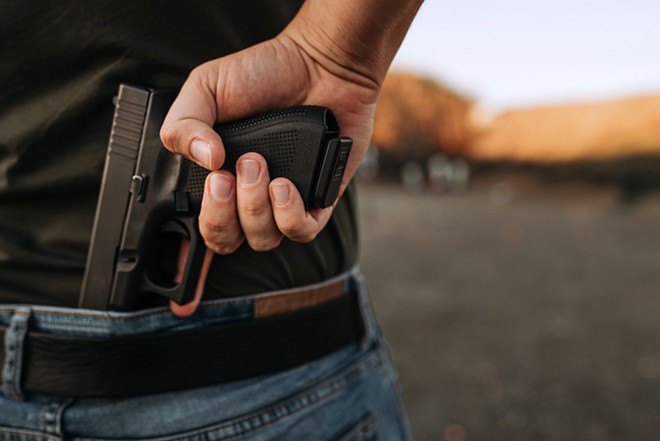For so many reasons, the Nov. 19 mass shooting at Club Q in Colorado Springs has been an absolute gut punch.
It evoked the massacre at Pulse, an Orlando LGBTQ club where, in 2016, 49 people were gunned down by a self-radicalized jihadist.
It took place at a drag show the day before Transgender Day of Remembrance, which honors those murdered in acts of transphobia, in a year marked by disgusting political attacks against transgender people by the likes of Florida Gov. Ron DeSantis.
It might be the product of ingrained self-loathing. According to their defense attorneys, the alleged shooter, 22-year-old Anderson Lee Aldrich, identifies as nonbinary and uses they/them pronouns. Their father, MMA coach Aaron Brink, told a CBS affiliate in San Diego that his first thought after hearing from his child’s public defender was to ask why his kid was in a gay bar.
“And then I go on to find out it’s a gay bar. I said, ‘God, is he gay?’ I got scared, ‘Shit, is he gay?’ And he’s not gay, so I said, ‘Phew.’ I’m a Mormon. I’m a conservative Republican. We don’t do gay.”
Another disturbing detail: Aldrich’s arrest a year ago for threatening their mother with a homemade bomb should have triggered Colorado’s red flag law, enabling authorities to seize their guns. But El Paso County declared itself a “Second Amendment sanctuary,” and police there haven’t seemed concerned about enforcing the law.
But here’s the thing I can’t get over: An unarmed brewery owner — aided by a trans woman who drove her heels into the shooter’s face, God bless her — did more to stop the carnage at Club Q than the locked-and-loaded cops of Uvalde, Texas, did at an elementary school in May. Five people died instead of dozens.
A veteran of Afghanistan and Iraq who was twice awarded the Bronze Star, Richard Fierro responded by instinct. When the shooting started, Fierro — who was there with his wife, daughter, and her boyfriend — pulled the shooter to the floor from behind, dislodging their rifle, grabbed their pistol from their hand, then beat the shit out of them.
Fierro’s wife and daughter survived with only minor injuries. His daughter’s boyfriend didn’t make it.
“I don’t know how I got the weapon away from that guy, no idea,” he told the New York Times. “I’m just a dude, I’m a fat old vet, but I knew I had to do something.”
Like many vets, Richard Fierro had trouble leaving the war behind. He came home in 2013 on edge. He saw a shrink and started taking meds. He also got rid of his guns. Put a pin in that.
Club Q was followed just three days later by a mass shooting in a Chesapeake, Virginia, Walmart that claimed six victims, all store employees. Chesapeake was the 607th mass shooting of 2022, according to the Gun Violence Archive, which defines mass shootings as incidents in which four or more people are shot.
As I wrote this on the morning of Nov. 28, 10 more incidents had been added to the list.
Using a narrower definition — active-shooter incidents in populated areas that produced three or more fatalities — Chesapeake marked the year’s 12th mass shooting, tying 2018 for a record that dates back at least 40 years, with a month yet to go. Seventy-four people have died in these incidents this year.
For comparison, from 1994 to 2004 — the 10 years in which we had a federal assault weapons ban — 17 mass shootings killed 106 people. It’s almost like we were on to something.
But despite the proposal’s popularity and Democratic control of Washington, Congress hasn’t restored the assault weapons ban. Nor did Democrats ban high-capacity magazines or subject private sales to background checks, both of which have majority support. Instead, after Uvalde, Congress cobbled together a bipartisan nothing-burger.
Chesapeake wasn’t perpetuated with an assault rifle, however. The killer used a handgun — as did killers in 155 of the 268 mass-fatality active-shooter incidents since 1982.
Handguns are used in about 80% of murders in the U.S.; in 2020, more than 19,000 people were shot to death. A new report found that the number of Americans carrying a loaded handgun every day doubled to 6 million between 2015 and 2019. Not surprisingly, most were white, male and lived in states with less restrictive gun laws.
Most gun carriers say they need protection from other people. But the evidence for defensive gun use is sketchy; the best data indicates that guns are seven times more likely to be used in a crime than to defend a victim, and only 1-2% of crime victims use a gun defensively.
“What we do know for sure,” David Hemenway, director of the Harvard Injury Control Research Center, told The Trace, “is that having a gun in your house increases suicides, it increases gun accidents, and it increases homicides, at least of women in the house.”
Guns are, in fact, used in most suicides, and are more common in suicides than murders. Most firearm suicides involved handguns that are stored unlocked and loaded so owners can have quick access protection. But we know that implementing even small barriers can cause people to rethink their suicidal impulses; not having guns anywhere near them is an even better deterrent.
We also know that states with the loosest gun laws (e.g., Mississippi, Louisiana, Wyoming) had the highest rates of gun deaths in 2020, and states with the most restrictive laws (e.g., Hawaii, Massachusetts, New Jersey) had the lowest.
And we know that while nearly 80% of homicides in the United States — which has more than twice as many guns per capita as Yemen, the world’s second-most gun-friendly country — are carried out with firearms, compared with only 4% of homicides in the U.K., which also has less than one-fourth of America’s homicide rate.
Maybe miss me with the “guns don’t kill people” thing.

